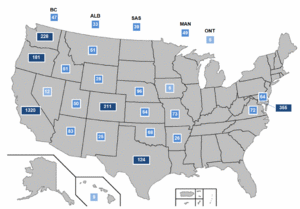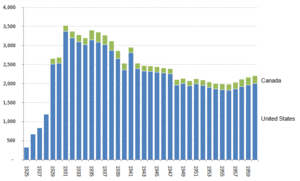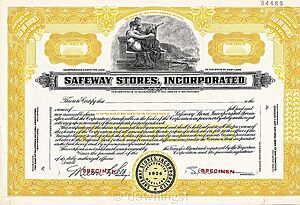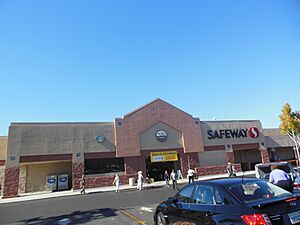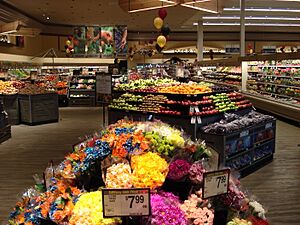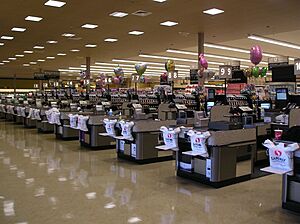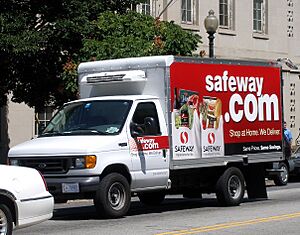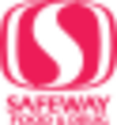Safeway facts for kids
 |
|
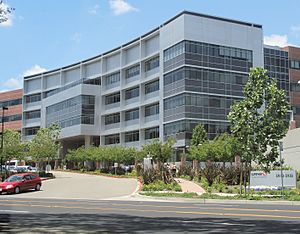
Safeway headquarters in Pleasanton, California, United States
|
|
| Subsidiary | |
| Traded as | NYSE: SWY |
| Industry | Retail / grocery |
| Founded | 1915 |
| Founder | M.B. Skaggs |
| Headquarters | Pleasanton, California, U.S. |
|
Number of locations
|
904 |
|
Area served
|
Alaska, Arizona, California, Colorado, Delaware, District of Columbia, Hawaii, Idaho, Maryland, Montana, Nebraska, Nevada, New Mexico, Oregon, South Dakota, Virginia, Washington, and Wyoming |
|
Key people
|
CEO Susan Morris |
| Products | Bakery, dairy, delicatessen, dry cleaning, frozen foods, fuel, grocery, lottery, pharmacy, photographic processing, produce, meats, snack food, liquor, flowers, and Western Union |
| Services | Supermarket |
| Total assets | US$17.2 billion |
|
Number of employees
|
|
| Parent | Albertsons (2015–present) |
Safeway, Inc. is a well-known American supermarket chain. It sells groceries, food, and many other items. You can find special departments like bakeries, delis, flower shops, and pharmacies inside Safeway stores. Some even have Starbucks coffee shops and gas stations!
Safeway mainly operates in the Western United States. You can also find some stores in the Mid-Atlantic region on the East Coast. Since January 2015, Safeway has been part of Albertsons. Its main office is in Pleasanton, California.
Contents
The Story of Safeway
How It All Started
Safeway began with a man named Marion Barton Skaggs. He already knew a lot about the grocery business. In 1921, he opened four grocery stores in Portland, Oregon. His stores grew very quickly.
By 1926, Skaggs had 428 stores across 10 states. That same year, he made his business much bigger. He merged his company with 322 stores from the Sam Seelig Company. They decided to call the new company "Safeway, Inc." Skaggs believed a big company should have a name that would last forever, not just his family name.
Why "Safeway"?
The name "Safeway" was chosen for a special reason. Back then, many grocery stores let customers buy food on credit. This meant families could get into debt. Safeway stores only accepted cash. This was seen as the "safe way" to buy food because families wouldn't owe money for groceries. Their first slogan was: "Drive the Safeway. Buy the Safeway."
Growing Bigger and Better
The big merger in 1926 happened because of Charles E. Merrill. He was the founder of the Merrill Lynch company. He saw a chance to bring many grocery stores on the West Coast together. Merrill helped combine Skaggs' stores with the Safeway chain.
After the merger, M.B. Skaggs became the head of the business. Two years later, Safeway's stock was listed on the New York Stock Exchange. In the 1930s, Safeway introduced new ideas. They started pricing produce by the pound. They also added "sell by" dates on fresh foods. Safeway even created some of the first parking lots for shoppers.
The merger made Safeway the largest grocery chain west of the Mississippi River. The company's main office moved from Reno, Nevada, to Oakland, California, in 1929. Later, in 1996, it moved to its current home in Pleasanton, California.
Standing Up for Rights
In the late 1930s, a group called the New Negro Alliance protested against a Safeway-owned store. They wanted the store to hire more Black people, especially in Black neighborhoods. This led to an important court case in 1938. The U.S. Supreme Court decided that people had the right to peaceful protest in disagreements about jobs.
Later, in 1969, two other groups, the Black Panther Party and the United Farm Workers, also protested Safeway stores. The Panthers wanted Safeway to help their Free Breakfast for Children Program. The United Farm Workers were protesting because Safeway continued to sell California grapes. The union had asked people not to buy these grapes to support farm workers. These groups often worked together to support each other's goals.
Expanding Across the Country
Safeway's stock first sold for $226 in 1927. Over the next few years, Charles Merrill helped Safeway buy many other regional grocery store chains. This was a strategy to grow the company quickly. They bought parts of the Piggly Wiggly chain and many others.
Most of these deals involved trading company shares, not much cash. Many of the acquired chains kept their original names until the mid-1930s.
The number of Safeway stores reached its highest point at 3,400 in 1932. After that, expansion slowed down. The Great Depression affected the company, and it focused on controlling costs. Also, smaller grocery stores were being replaced by larger supermarkets. By 1933, Safeway was the second-largest grocery chain, behind The Great Atlantic & Pacific Tea Company.
In 1936, Safeway started offering a money-back guarantee on meat.
Going International
Safeway also expanded into other countries:
- Canada in 1929. This part of the company was sold to Sobeys in 2013.
- The United Kingdom in 1962. This became Safeway plc.
- Australia in 1963. This became Safeway Australia.
- West Germany in 1964.
The company also had stores in Saudi Arabia and Kuwait through special agreements in the 1980s. In 1981, Safeway bought a part of a Mexican retailer called Casa Ley. Safeway usually grew internationally by buying smaller chains in those countries.
The Mid-Century Years (1940s–1970s)
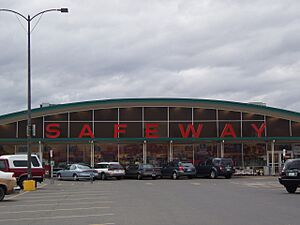
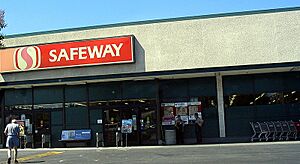
In 1941, Marion B. Skaggs retired from the Safeway board. By 1947, the company's sales went over $1 billion for the first time. In 1962, Safeway started using the "S" logo that you still see today.
In 1959, Safeway opened its first store in the new state of Alaska. This made it the first major food store to enter that market. They opened several stores in Anchorage and Fairbanks.
Also in 1959, Safeway opened its first "marina-style" store in San Francisco. These stores had a unique barrel-vaulted roof. Many hundreds of stores were built in this style over the next ten years.
In 1963, Safeway opened stores in Hawaii again, after leaving that market years before.
In 1977, Safeway had a problem with fake $100 bills. They told employees that bills without "In God We Trust" were fake. However, some real bills from that time did not have the phrase. An innocent shopper was wrongly arrested. This led to a court case where Safeway had to pay money for the mistake.
In 1979, Peter Magowan, the grandson of Charles Merrill, became the head of Safeway. He led the company for the next 13 years.
Changes in the 1980s
In 1986, Safeway was bought by a company called Kohlberg Kravis Roberts (KKR). To pay off the huge debt from this purchase, Safeway started selling off many of its store divisions.
Many of the Safeway divisions sold in the U.S. had problems for the new owners. Most of them faced financial difficulties or were later bought by other companies. However, the international stores that were sold did better for their new owners.
Safeway sold its stores in Southern California to the Vons Companies in 1988. Safeway also reduced its operations in other parts of California. Nearly half of the 2,200 stores in the chain were sold during this time. Safeway's presence in the U.S. was mostly in several western states and Northern California, plus the Washington, D.C. area.
Growth in the 1990s
Safeway became a public company again in 1990. The late 1990s and early 2000s saw Safeway expand rapidly into new areas. In 1997, Safeway bought the rest of the Vons Companies, getting its Southern California stores back. In 1998, they bought Dominick's Finer Foods in Chicago. In 1999, they bought Carrs-Safeway in Alaska and Randall's Food Markets in Houston and Austin, Texas. Randall's also owned Tom Thumb stores in the Dallas-Fort Worth area. The purchase of Randall's also meant Safeway started having gas stations at its stores.
In 2000, Safeway began offering grocery delivery. In 2001, they bought the Genuardi's chain, which had stores in Pennsylvania, New Jersey, and Delaware. Safeway also created Blackhawk Network, a company that deals with prepaid cards and financial solutions. Genuardi's was the last grocery chain Safeway bought.
"Lifestyle" Stores
By the early 2000s, Safeway's expansion outside the West Coast was not going well. To make its stores more appealing, Safeway started a big project in 2005 called "Ingredients for life."
This project included a new logo and a new slogan. Many stores were changed to the "Lifestyle" format. These new stores had a warm, inviting look with softer lighting. They also had new employee uniforms, sushi bars, olive bars, and Starbucks coffee shops inside. This new design helped increase sales. By the end of 2006, Safeway's shares were up, showing the rebranding was a success.
In 2011, Safeway partnered with UNFI to get natural, organic, and specialty products for all its stores.
Decline and Sale to Albertsons
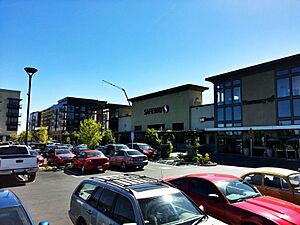
In 2012, Safeway closed or sold its Genuardi's stores in the Philadelphia area. Other grocery chains like Giant and Weis bought some of these locations.
Also in 2012, Safeway's CEO, Steve Burd, made a deal to put Theranos blood-testing locations in 800 Safeway stores. This project cost $350 million. The idea was to get blood test results quickly while shopping. However, the deal failed, and both the company and CEO Burd lost a lot of money. The spaces meant for Theranos labs were later used for other purposes or the stores closed.
In 2013, Sobeys announced it would buy Safeway's operations in Canada for CAD$5.8 billion. This helped Sobeys become stronger in Western Canada. Sobeys completed the sale later that year. The stores kept the Safeway name but started using Sobeys' own brands.
In October 2013, Safeway announced it would close and sell its remaining Dominick's stores in the Chicago area by early 2014.
On March 6, 2014, Albertsons, a longtime competitor, announced it would buy Safeway for $9.4 billion. The deal was completed in January 2015. As part of the purchase, Blackhawk Network became an independent company. Safeway's own food products were then sold in all Albertsons-Safeway stores.
Safeway as a Supermarket Brand Today
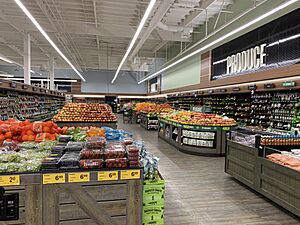
When the merger between Safeway and Albertsons was finalized in January 2015, some stores had to be sold to other companies. This was to meet anti-monopoly rules. A grocery chain called Haggen bought 146 Vons, Albertsons, and Pavilions stores across several western states.
After the purchase, Safeway and its other brands like Randalls, Tom Thumb, Vons, and Pavilions became part of Albertsons' operations. Safeway's own food products were then sold in all of the Albertsons-Safeway stores.
In November 2016, Safeway Inc. agreed to buy Andronico's stores, which were mainly in the San Francisco Bay Area. By February 2020, some Safeway stores began operating under the Andronico's Community Market name. Today, these stores are managed in a special way, similar to how Andronico's ran when it was independent.
[[Multiple image | image1 = 0999Front.jpg | caption1 = | image2 = NewFrontEnd.jpg | direction = vertical | caption2 = Front lobby/register area in an updated store ]]
Starting in 2018, Safeway and Albertsons began updating stores with a new look. This new design uses brighter colors and LED lighting.
In 2019, Safeway was ordered to pay a fine of $12 million. This was because a cashier in California was not allowed to sit, even though state law says workers should have "suitable seats."
In August 2021, Safeway launched FreshPass. This is a paid service that offers free unlimited delivery and pickup. It also gives members special discounts. The "Just for U" rewards program was also simplified to "for u" as part of this launch.
Other Albertsons stores in different areas have also changed their names to Safeway.
In October 2022, Albertsons and its competitor, Kroger, announced a plan to merge. This merger has faced challenges in court from some states. For example, in February 2024, the Colorado Attorney General filed a lawsuit. He said the merger "would lead to stores closing, higher prices, fewer jobs, worse customer service, and less resilient supply chains."

Safeway's Own Brands
In 2006, Safeway introduced a line of organic products called "O Organics." This brand has been very successful, with sales over $1 billion in 2017. "Open Nature" was launched in 2011 and has also done well. It has even taken over some other Safeway brands.
After Albertsons bought Safeway, the combined company started using Safeway's own brand program. They changed the name from "Safeway Select" to "Signature Select." They also updated the look of the packaging for all their products.
Grocery Delivery Services

Safeway has offered online grocery delivery in some areas since 2000. This service has grown to cover many states. Safeway has also quickly added "DriveUp & Go," which lets you pick up your groceries at the store. They also offer traditional delivery and on-demand deliveries through services like Instacart and DoorDash.
In January 2021, Albertsons announced it would be laying off its own grocery delivery drivers in Northern California. They decided to use app-based delivery platforms instead. However, all affected employees were offered other jobs within the company.
Past Store Ideas
Over the years, Safeway has tried out different store concepts:
- In 1963, Safeway created the Super S format. This combined a general merchandise store, a drug store, and a new Safeway supermarket in one building. They shared an entrance but operated as separate businesses. Safeway sold these stores by 1971.
- In 1964, Safeway opened a special two-level International Store in Washington, D.C. It had a regular Safeway downstairs and a gourmet food store upstairs. This store sold unique items like wild boar steaks and reindeer steaks.
- The company also tried to reuse older, smaller store sites. They opened Food Barn, a discount grocery store, and Liquor Barn, a discount liquor store, in the 1970s. Safeway also tested "Town House" stores, which were small stores for people living in apartments. They also had a gourmet store idea called "Bon Appetit."
- Safeway also acquired Pak 'n Save Foods. These were warehouse-style stores that sold items in bulk. Today, these stores are mostly the same as regular Safeway supermarkets. As of 2025, only two Pak 'n Save locations remain.
Safeway Logos
Safeway Company Information
Support Offices
- California
- Pleasanton, California (Headquarters), Customer Service, IT Support, Pricing
- Colorado
- Denver, Colorado (Offices, Security, Trucking)
- Arizona
- Phoenix, Arizona (Offices, Accounting, IT)
- Maryland
- Lanham, Maryland (Eastern U.S. Headquarters)
Music and Announcements in Stores
The music you hear in Safeway stores comes from Stingray Advertising. This network also plays commercials for Safeway products. The unique "Attention Service Desk" announcements are used to tell employees about phone calls.
Animal Welfare Efforts
In 2012, Safeway announced it would ask its pork suppliers to stop using gestation crates. These are small pens for pigs.
In 2008, Greenpeace started ranking major supermarkets on how well they supported sustainable seafood. This means buying fish in a way that doesn't harm ocean life. Safeway ranked well in 2013. They made sure their canned tuna was caught sustainably. They also supported policies to protect the ocean.
In 2016, Safeway's parent company, Albertsons, joined other companies in moving towards "cage-free" egg production. They planned to use only cage-free eggs by 2025. This happened after campaigns by groups like The Humane League.
|
See also
 In Spanish: Safeway para niños
In Spanish: Safeway para niños
- List of supermarket chains in the United States
- Safeway (Australia)—Sold to Woolworths Limited Australia in 1985. All locations renamed to Woolworths Supermarkets from 2008 to 2017.
- Safeway (Canada)—Sold to Sobeys in 2013. Continues to use the Safeway banner.
- Safeway (UK)—Sold to Argyll Foods in 1987. Continued to use the Safeway name until 2005, after they were acquired by Morrisons in 2004.


